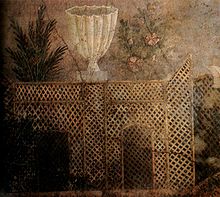Casa dei Cubicoli floreali
The Casa dei Cubicoli floreali (German house of rooms painted with flowers , also Casa del frutetto , house of the orchard , also house of Euplia ) (I 9, 5-7) in Pompeii was probably a very old house when the city fell. The first cubiculum contained remains of First Style decorations and the entrance is decorated with cube capitals. The whole house is not very large, has an atrium and a small peristyle , with all rooms only on one side and not grouped around the atrium and peristyle. At the entrance, a cast of the former wooden door leaves is still preserved today.
The outstanding thing about this house are three rooms that have been painted in the late 3rd style . The second cubiculum to the left of the atrium is decorated with a garden landscape. You can find oleander, laurel, myrtle, lemons and cherry trees, giving the impression that you are standing in a white pergola , from which you look out over the garden. Birds fly around among the plants. Small pictures are inserted into the individual wall sections and show Dionysian as well as Egyptian scenes. Egyptian statues are placed between the plants.
In the so-called black cubiculum, vessels of the Isis cult are depicted above the base , whereby this room has also been painted like an orchard (see pictures). Dionysus appears on the ceiling, galloping on a panther.
The triclinium is also painted with a black background, whereby the room was divided by painted pillars and has three large paintings and several small pictures.
All other rooms in the house are not painted. From around 100 wine amphoras that were found in the house, it was concluded that a wine merchant lived here. The rich painting with Egyptian motifs led to a shrine of Dionysus- Osiris being seen here, but it is difficult to determine whether these paintings were really made out of religious conviction or whether the owner simply had a penchant for the exotic.
literature
- Eugenio La Rocca, M. de Vos Raaijmakers, A. des Vos, Lübbes archaeological guide, Pompeji , Gustav Lübbe Verlag, Bergisch Gladbach 1979, ISBN 3785702280 , pp. 244-246.
Web links
- (numerous images, with 'watermarks')
- Reconstruction of the house, with various animations (in English)
Coordinates: 40 ° 45 ′ 3.2 ″ N , 14 ° 29 ′ 26.4 ″ E

